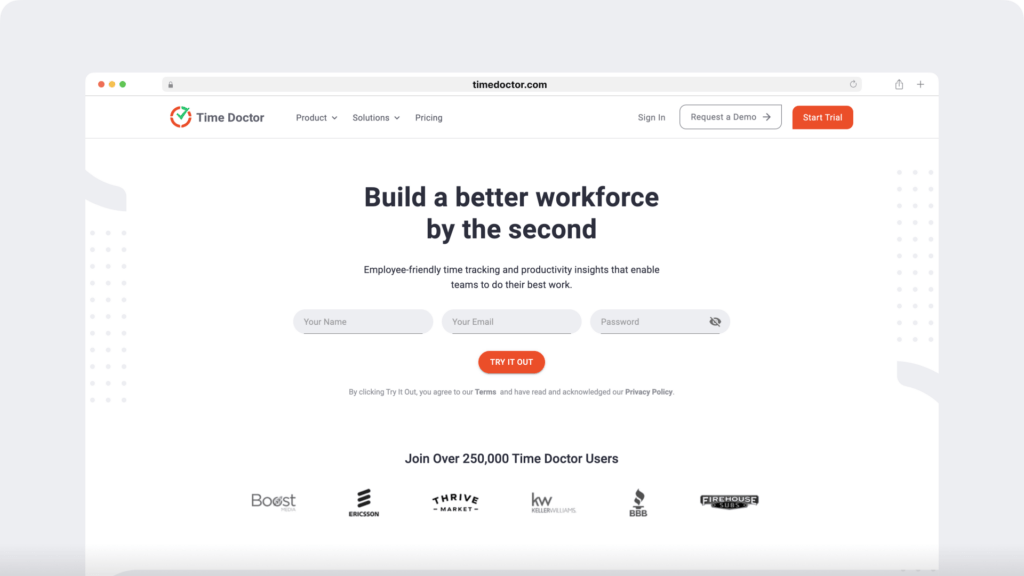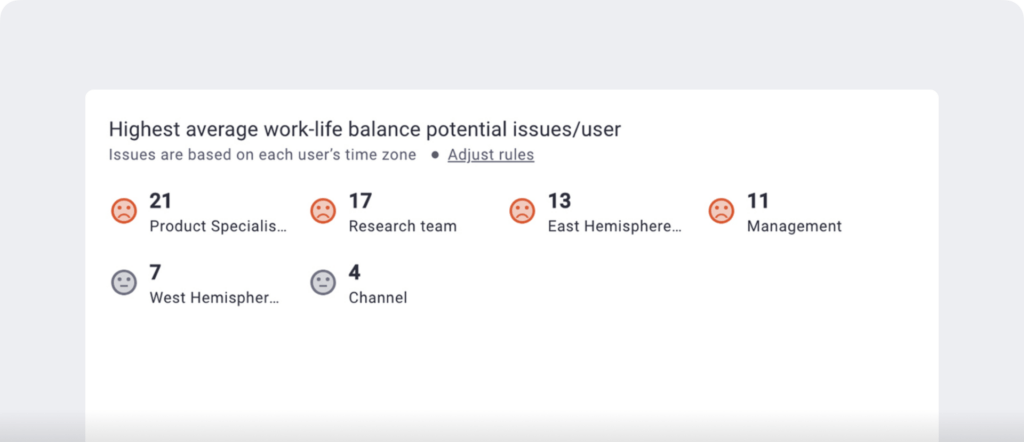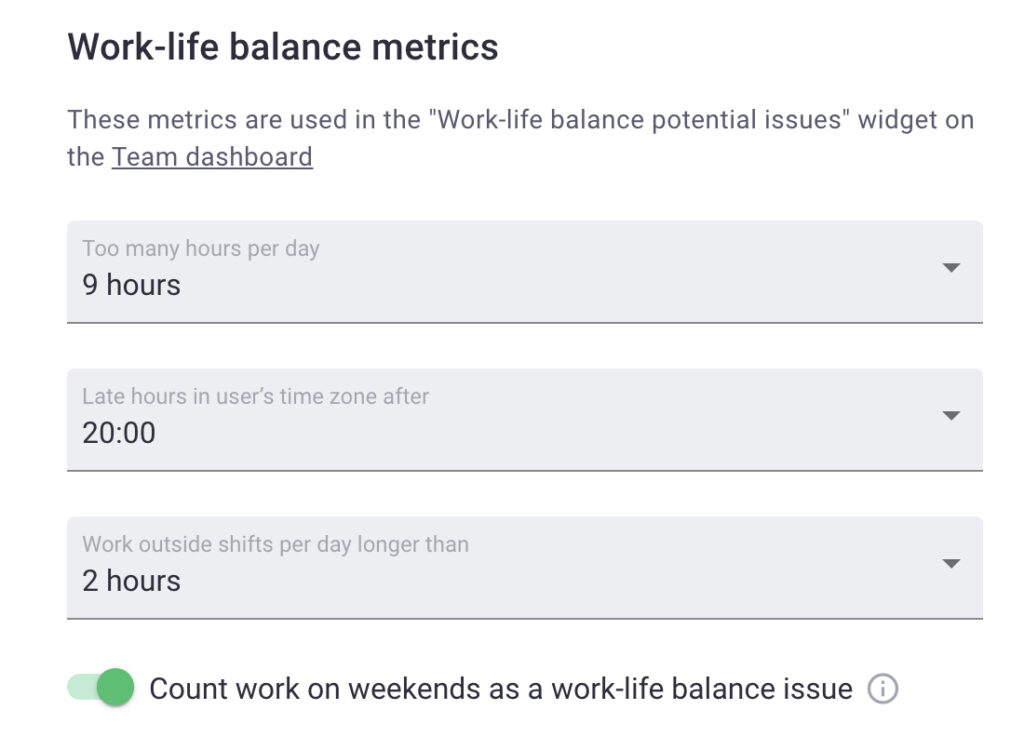Employee burnout is real and has been on the rise for the past few years.
In fact, after the pandemic, a Deloitte survey found that 64% of employees feel overly stressed and exhausted while at work – a dominant cause of the Great Resignation in 2022.
Employee burnout is also an obvious barrier to high productivity and output for many companies.
But how do you spot employee burnout signs?
And how do you deal with work burnout as a good manager?
This article will discuss seven signs of burned-out employees and show you a few ways to support them. We’ll also answer a few frequently asked questions about employee burnout.
Table of Contents
- The 7 common signs of employee burnout
- 3 effective ways to handle employee burnout
- A tool to help you spot the early signs of employee burnout
- 2 FAQs about employee burnout
Let’s get started.
The 7 common signs of employee burnout
Employee burnout means more than just needing a temporary break from workplace stress.
The World Health Organization describes it as a workplace condition that can affect every aspect of an employee’s work performance, including energy, motivation, and professional efficacy.
To keep high employee productivity and enthusiasm for work, you must spot job burnout early.
Here are a few of the most common signs your employee(s) might be getting burned out:
1. You notice an employee acting disengaged in work projects
Employees who no longer find joy in their work show signs of disengagement. This is an early burnout symptom.
How does low employee engagement look in the workplace?
Employees who feel disengaged during their workday may:
- Stop participating in team meetings. Has a former top contributor become silent during weekly meetings?
- Avoid taking on new projects. Has a team member stopped volunteering for new challenges?
- Stop returning emails or phone calls. Are you finding that you have to follow up with an employee over and over?
- Display poor feedback retention. Has a former top performer stopped taking steps to improve after receiving negative feedback?
A general lack of enthusiasm for their work shows that employees are disengaged due to burnout.
2. You see declining productivity or performance
Employees feeling burned out may experience a loss of purpose for work, resulting in reduced productivity.
But decreased productivity isn’t the only side effect of burnout, as the quality of their work also takes a hit. If you find an employee producing low-quality work at a slower rate than usual, this may be a warning sign of workplace burnout.
Before these issues escalate, it’s often helpful to connect with employees one on one. If you ask them about their challenges and concerns, you can sense whether reduced productivity and performance are due to burnout or other issues—such as insufficient team support.
3. You notice increasing absentee rates
Often all a burnt-out employee wants to do is get away. Stressed employees may take extra leave or more than one unnecessary sick day.
Employees who do this usually hope that short breaks from work can restore their productivity or alleviate their exhaustion and stress levels.
Unfortunately, job burnout is a more severe condition that can’t simply go away with a day off.
Although additional paid or unpaid time off may help alleviate burnout temporarily, keep in mind that this problem often requires a bigger solution. You may need to rethink team structures, workloads, and schedules.
4. You find yourself mediating more workplace conflicts
Workplace clashes and confrontations are routine and shouldn’t cause alarm—as long as they remain isolated and don’t cause long-lasting negative effects.
However, if you notice an employee getting into regular disputes with a co-worker and having an unusually cynical attitude, it could be because of job stress.
For example, you might notice that an employee reacts negatively to every new task or project assignment. Or you might find that an employee responds aggressively when a specific coworker contributes in meetings.
Common traits of a burnt-out employee may include increased irritability and excessive anger. In addition, they tend to be triggered easily in the workplace.
HR professionals can have one-on-one interactions with confrontational employees to have an unbiased understanding of the cause of the dispute.
5. You sense that employees are more sensitive to feedback
Adverse reactions to feedback go hand-in-hand with a cynical attitude. In many workplaces, employees receive constructive criticism regularly. It shouldn’t lead to overly negative reactions.
However, a burnt-out employee, who already feels stressed and unmotivated at work, may react negatively when told their work isn’t up to the mark. They may feel they are receiving unfair treatment.
Has an employee begun blaming coworkers or workflows for every mistake rather than using feedback constructively? An employee who reacts defensively (instead of receptively) to constructive criticism may signify job burnout.
Managers who give feedback should speak to such employees to try and identify the reasons for burnout. HR professionals can also help to resolve the employee’s stress.
6. You spot growing disinterest in company culture
A common burnout symptom is when an employee no longer feels valuable to the company and detaches from it as a defense mechanism.
Employees who are burnt out often feel as though they can’t provide much to their company. They may also think they don’t owe the company anything beyond their assigned tasks—which can lead to disinterest in events.
If you notice that an employee is always unaware of office events, doesn’t care about the company’s performance, and doesn’t give 100% attention to tasks – this may be a sign of job burnout.
7. You observe employees experiencing physical issues
Emotional exhaustion and stress can affect more than just mental well-being.
Employees who are under stress from working long hours may start experiencing various physical symptoms.
Common physical symptoms of burnout may include:
- Exhaustion.
- Panic attacks.
- Constant nausea.
- A loss of appetite.
- Drastic weight loss.
- Persistent colds.
- Headaches.
These symptoms threaten more than just the workplace performance of an individual employee. They could also negatively affect the health of your co-worker.
Have you noticed any of these burnout signs?
If yes, it’s time to take action.
Good managers must know how to handle workplace burnout.
Let’s go through a few ways you can optimize your workplace to help employees deal with burnout.
3 effective ways to handle employee burnout
Dealing with burnout isn’t something an individual employee can do independently. They’ll need support to deal with the stressors of a full-time job.
Try implementing a few of these helpful workplace techniques to ease the burden of burnout and increase employee engagement:
1. Talk with employees before they reach burnout
The most important step you can take to address employee burnout is to talk with them as soon as you spot warning signs. Ask them how they’re doing with prompts like:
- Have you been feeling overworked recently?
- What’s been your biggest challenge lately?
- Are you feeling stuck in your role or with your current task list?
- Do you feel like your recent performance has been good or bad?
- What’s the top thing you would change about your current role?
Rather than bringing up the issue in passing, make time for a one-on-one. This approach signals that you care about their wellbeing. It also ensures that you have enough time to discuss problems and solutions
Although some employees may only need more appreciation or an extra day off, some might require more advanced solutions. You might learn that employees need lighter workloads, more team support, or bigger budgets—so be prepared to talk about or follow up on these high-impact solutions.
2. Show appreciation frequently
Employee burnout often starts to bubble up when employees feel undervalued or think their work doesn’t matter.
As a manager, you should make every employee feel like a vital team member. Employees who feel like their work matters are far less likely to experience job burnout.
Something as simple as thanking an employee for getting work done on time or commending them for the quality of their work can go a long way in making an employee feel valued.
3. Give time off to burnt-out employees
Waking up every day and going through long hours at work is enough to make anyone feel burnt out.
To overcome that, employees must take time to shut off from work completely. They can use this break to spend time with friends and family members or getaway to reset their minds.
Having free time will engage employees to produce high-quality work when they return.
Asking an employee who displays signs of burnout if they need some time off or a sick day may help.
This may improve employee morale and make them value the position they hold.
A tool to help you spot the early signs of employee burnout
Productivity management software like Time Doctor can help you spot employee burnout before it’s too late. After all, one of the biggest problems with burnout is that employers often find out after the fact.
If you wait until your staff quits or “quiet quits” then it may be too late to take action or fix the situation. That’s why it’s so important to learn how to spot the warning signs.
With Time Doctor, you can get automated insights about potential burnout. Then you can work with stressed employees to manage their workload and schedules.
Time Doctor can also boost employee productivity and help your team spend their time efficiently. It’s a win-win situation for you and your team.
What is Time Doctor?

Time Doctor is a powerful employee productivity and performance management software used by small businesses like Thrive Market, as well as large firms like Ericsson. It’s useful for managing both, in-office and remote employees.
The tool has an interactive timer that helps track the time employees spend on their tasks. It enables managers and employees to:
- Track how they spend their hours.
- See which projects take up the most time.
- Ensure employees take adequate breaks.
And more.
Gaining insights into how employees manage their time might provide valuable information about why they are feeling burnt out. It can help you create workable schedules and prevent employee burnout without losing productivity or quality of work.
The best part?
Time Doctor provides managers with the Work Life Balance Widget that can help detect and prevent employee burnout before it occurs.
With this widget, managers can find out which employees are working:
- More hours than necessary every day.
- Too many extra shifts.
- Later than other co-workers.
- Over the weekends.
The widget automatically highlights employees with the most work-life issues, based on your own custom rules. The moment a team member crosses a preset threshold or develops negative patterns, you can intervene.

You can take actions like setting clear expectations for work hours or learning where employees need additional support. Taking these steps can reduce the risk of burnout and lead to happier, more productive employees.

Understanding these work metrics can help managers understand work trends of employees. They can then intervene and set clear expectations regarding work hours. These steps can greatly reduce the risk of burnout.
Want to see this tool in action? Watch a demo of the Work Life Balance widget to see how it can help your team.
Now let’s go through frequently asked questions about employee burnout.
2 FAQs about employee burnout
Here are the answers to some of the most common queries about chronic workplace stress and burnout.
1. What are some common causes of employee burnout?
Understanding the causes of burnout can help managers take precautionary measures right from the start.
Some of the leading causes of work burnout include:
- Unclear expectations.
- Heavy workload.
- A toxic work environment.
- Physical and emotional exhaustion.
- Being micromanaged.
- Lack of support from managers and co-workers.
- Unfair treatment from higher management.
As a manager, you should aim to minimize these causes in the workplace to halt unnecessary burnout.
2. How can managers create a workplace that prevents burnout?
The work environment can easily become a risk factor that creates burnout and chronic stress.
To prevent that, you should:
- Create a workplace that acknowledges that burnout can happen. Ask HR leaders to have an open dialogue with employees about work related stress, mental health, and workload to prevent occurrences of burnout.
- Communicate how employees can deal with chronic stress, such as maintaining a healthy work life balance, meditation, and self-care in their personal life. Consider setting up a wellness program for employees who are struggling.
- Ensure that your employees feel heard by encouraging them to see HR leaders or visit a healthcare professional like a psychologist to maintain good mental health.
A supportive workplace that openly acknowledges burnout and sets clear expectations will improve employee morale.
This kind of open and friendly company culture can foster healthy and happy employees.
Wrapping up
It’s important that managers and leaders pay attention to the behaviors and needs of their employees in the workplace. You should look out for burnout signs like disengagement, increased absenteeism, and low productivity to identify employees who are struggling.
Once you properly understand the signs of burnout you can take action and help your employees get back on their feet.
Creating a healthy company culture by implementing productivity software like Time Doctor is a good start.
So, why not try out Time Doctor’s 14-day free trial to experience its benefits yourself?

Liam Martin is a co-founder of Time Doctor which is software to improve productivity and help keep track and know what your team is working on, even when working from home.


